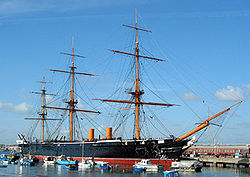Norman
In the Domesday Book there is no mention of Portsmouth. However, settlements that later went on to form part of Portsmouth are listed. These are Buckland, Copnor, Fratton on Portsea Island and Cosham, Wymering and Drayton on the mainland. At this time it is estimated the Portsmouth area had a population not greater than two or three hundred.
While in the primary diocese of Portsea there was a small church prior to 1166 (now St Mary's in Fratton) Portsmouth's first real church came into being in 1181 when John of Gisors granted an acre (4,000 m2) of land to Augustinian monks at the Southwick Priory to build a chapel dedicated to Thomas Becket. This chapel continued to be run by the monks of Southwick Priory until the Reformation after which its possession was transferred to Winchester College. The modern Portsmouth Anglican Cathedral is built on the original location of the chapel. [1] The original grant referred to the area as Sudewde however a later grant a few years later used the name Portsmouth. [1]
Growth of the city
In 1194, after he returned from being held captive by Duke Leopold V of Austria, King Richard I (The Lionheart) set about summoning a fleet and an army to Portsmouth, which he had taken over from John of Gisors. [2] On 2 May 1194 the king gave Portsmouth its first royal charter granting permission for the city to hold a fifteen-day annual fair (which became known as the Free Market Fair), weekly markets (on Thursdays), to set up a local court to deal with minor matters, [2] and exemption from paying the annual tax ("farm") of £18 a year—instead the money would be used for local matters. The actual physical charter was handed over by the Bishop of Ely William de Longchamps. [2] The present location of the charter is currently unknown but its text survives, as when later royal charters were granted to the city reaffirming and extending its privileges large parts of the original charter were quoted verbatim.
As a crescent and an eight-point star (as appear on the city's coat of arms) were to be found on both the seals of King Richard and William de Longchamps it is commonly thought that this may have been the source of them, although there is no known documentary evidence for this.
King Richard later went on to build a number of houses and a hall in Portsmouth. [3] The hall is thought to have been at the current location of the Clarence Barracks (the area was previously known as Kingshall Green).
In 1200 King John issued another charter to Portsmouth reaffirming the rights and privileges awarded by King Richard. [3] Acquiring this second charter cost Portsmouth ten marks and a type of riding horse known as a Palfrey. [3] King John's desire to invade Normandy resulted in the establishment of Portsmouth as a permanent naval base. [4]
In 1212 William of Wrotham (Archdeacon of Taunton, Keeper of the King's Ships) started constructing the first docks of Portsmouth. At about the same time Pierre des Roches, Bishop of Winchester, founded Domus Dei (Hospital of St Nicholas) which performed its duties as an almshouse and hospice until 1540 when like other religious buildings it was seized by King Henry VIII.
During the 13th century, Portsmouth was commonly used by King Henry III and Edward I as a base for attacks against France.
In 1265, the city was on the receiving end of a serious raid by the Barons of the Cinque Ports. [5] After scattering the defenders, they seized various ships and cargo and burned the town. [5]
By the 14th century, commercial interests had grown considerably, despite rivalry with the dockyard of nearby Southampton. Common imports included wool, grain, wheat, woad, wax and iron, however the port's largest trade was in wine from Bayonne and Bordeaux.
14th century
In 1313, the town received a charter from Edward II. [6] This is the oldest of the city's charters that is known to have survived. [6]
In 1338, a French fleet led by Nicholas Béhuchet arrived at Portsmouth docks flying English flags before anyone realised that they were a hostile force. The French burned down most of the buildings in the town; only the local church and Domus Dei survived. The population was subjected to rape and slaughter. As a result of this, King Edward III gave the remaining townsfolk exemption from national taxes so that they could afford to rebuild the town.
Only ten years after this devastation, the town for the first time was struck by the plague known as the Black Death. In order to prevent the regrowth of Portsmouth as a threat, the French again sacked the city in 1369, 1377 and 1380.





